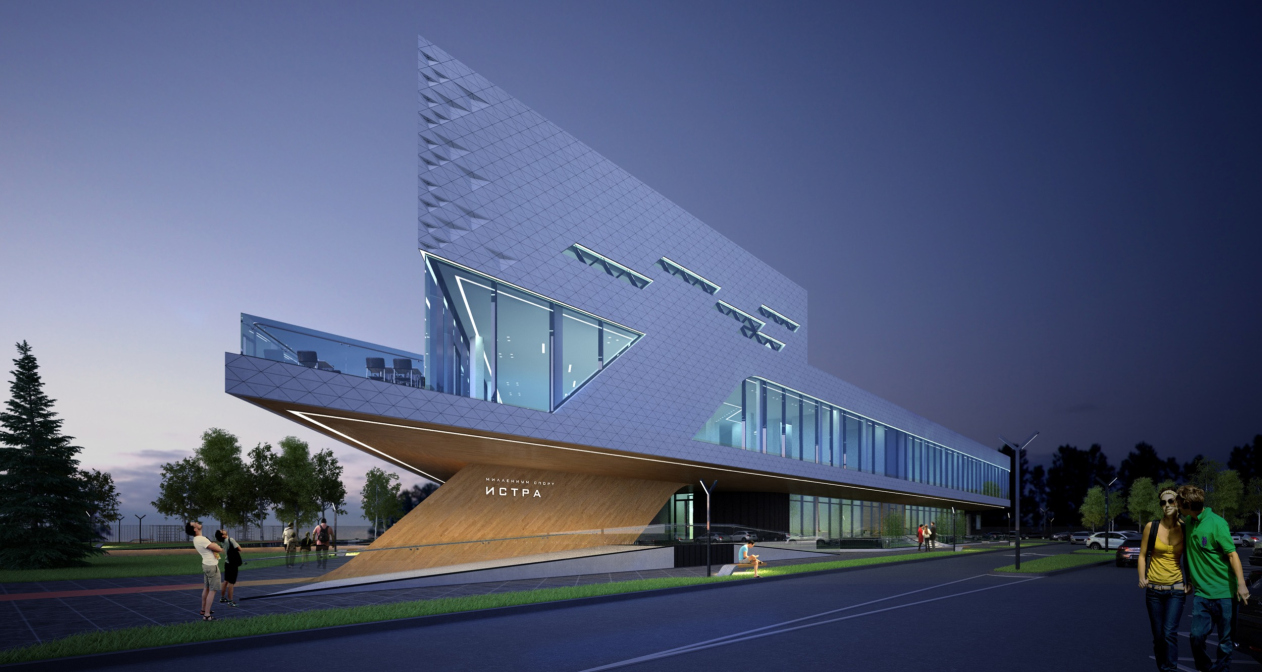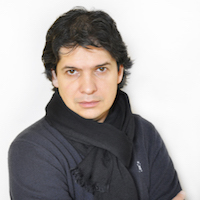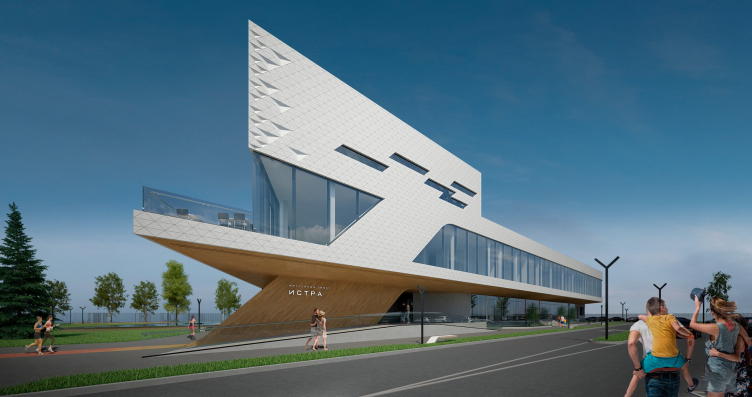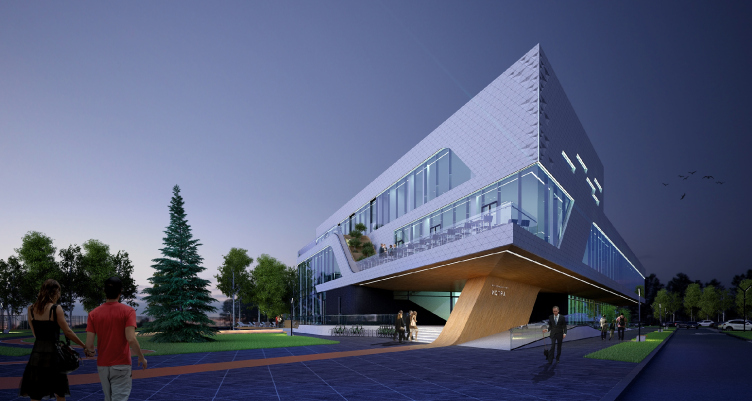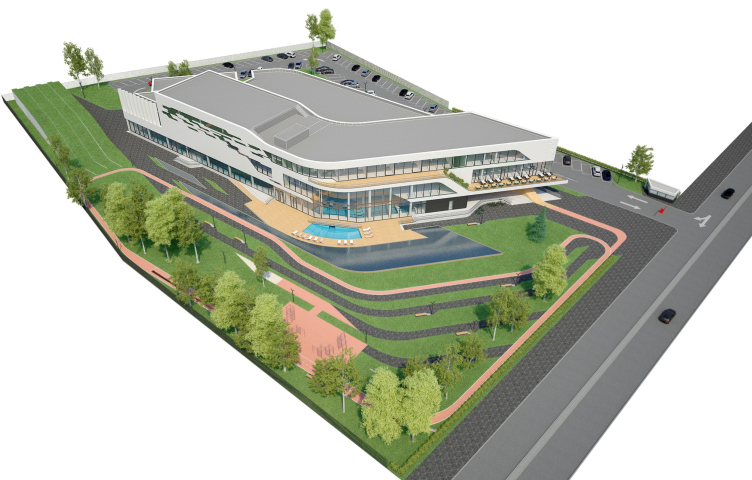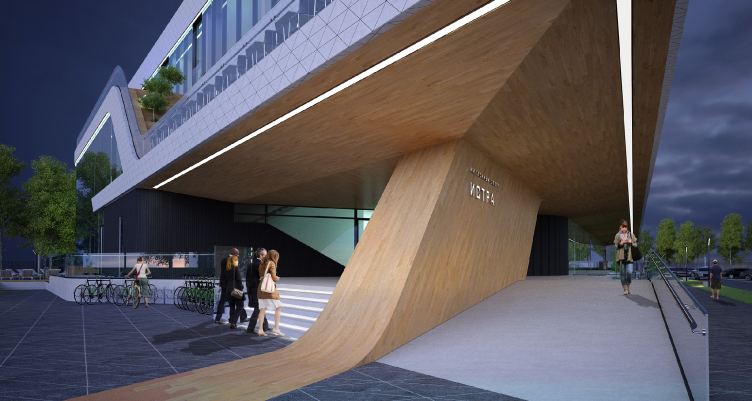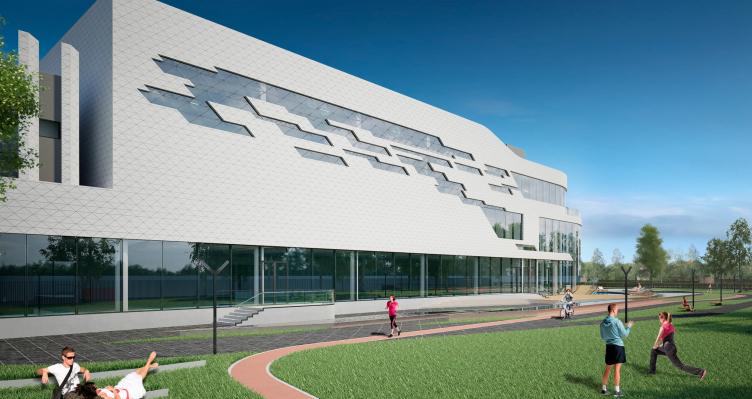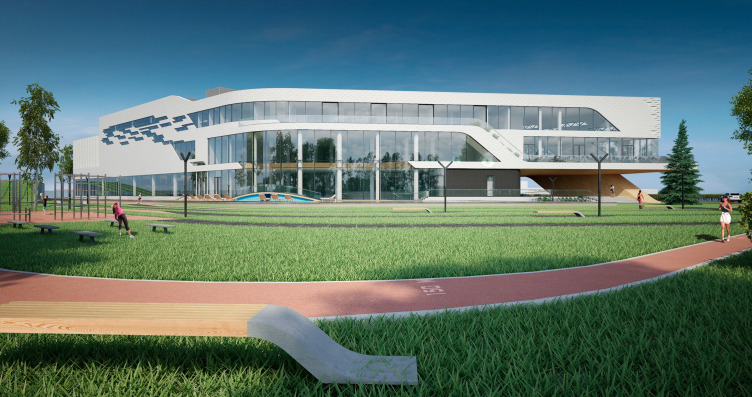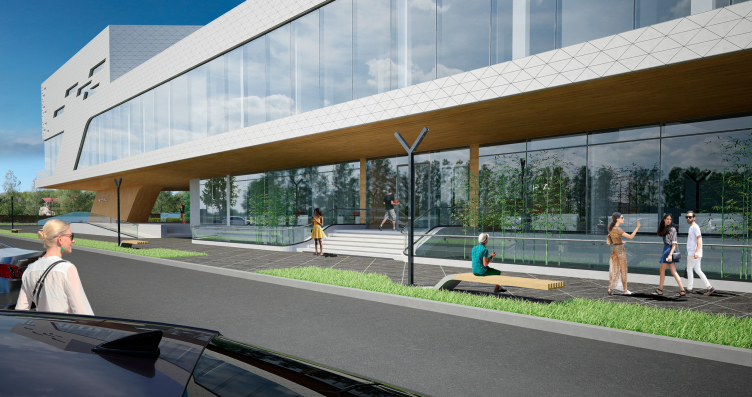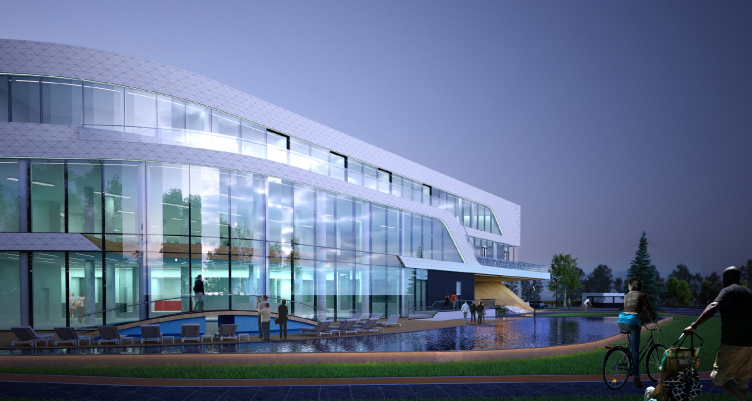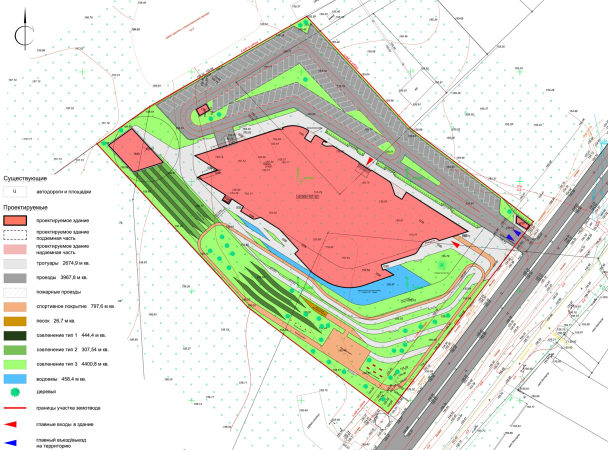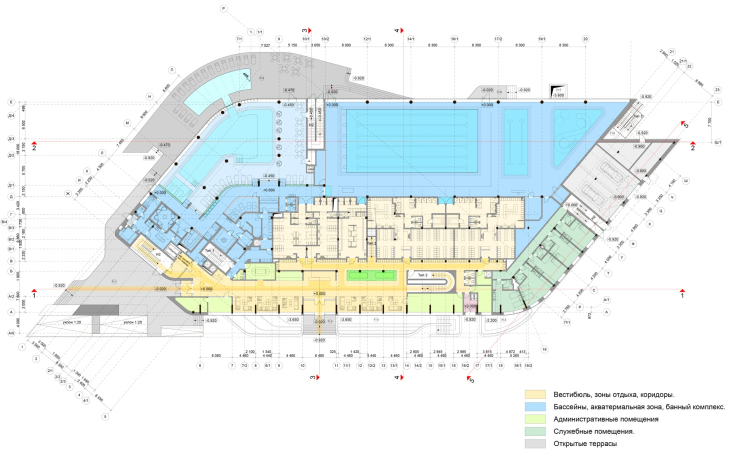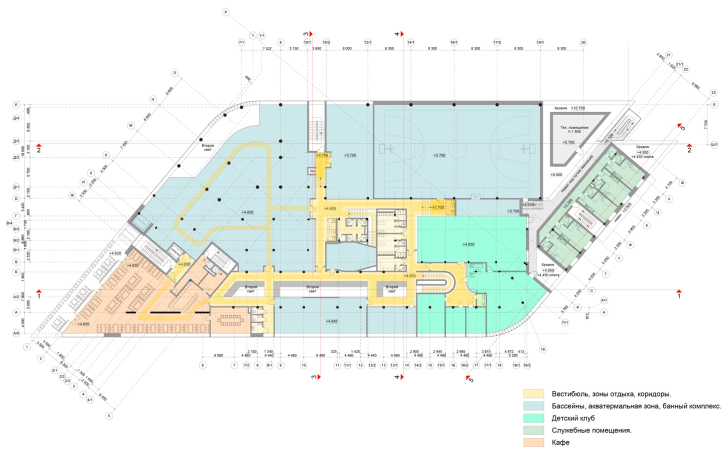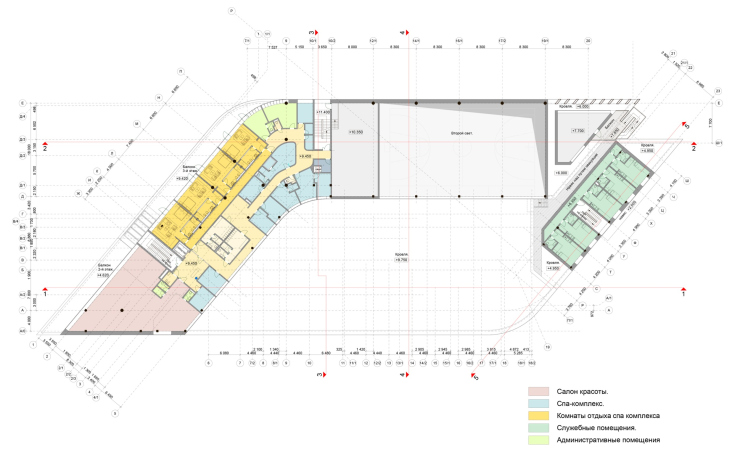Millenium Sport multifunctional fitness center
Copyright: © ARS-ST, 4izmerenie
The land site is devoid of any significant limitations, and the architects were granted complete freedom of self-expression. Seemingly so! If we are to take a closer look at the task posed by the client – and in this project it was a very exacting client – it will become clear that the search for the right compositional solution was quite a tall order. The 1.78-hectare land site was to include an indoor fitness club with a total area of 10 661 square meters with an extensive program for doing outdoor sports and a capacious parking lot. Considering the flat character of the project and the large size of the construction blueprint, the architects had to consider a few different options before getting down to “dissecting” the territory.
“This original idea gave birth to a single volume that dissects the land site into the southwest major part, the grand one with lots of landscaping work, alpine knolls, a workout area and playgrounds, and the northeast minor part, with a parking lot and a utility section” – explains the leader of the author team, Vsevolod Medvedev.
Millenium Sport multifunctional fitness center
Copyright: © ARS-ST, 4izmerenie
The metaphor of dissecting the land site was turned by the architects into a very specific shape – a sharp “bow” or “breakwater” that creates a steady image of something flowing in space. Beneath the “breakwater”, there is an entrance for those who arrived to the club on foot or by bicycle. Above it, on the second floor, there is a restaurant with an open-air terrace.
Millenium Sport multifunctional fitness center
Copyright: © ARS-ST, 4izmerenie
There is a sharpish deconstructivist look about this “snout”, yet, at the same time, as if suddenly remembering that there are meadows all around, the architects softened it with wood-imitating finish. The wood, or, rather, its imitation, makes this futuristic statement sound more down-to-earth, make it more “ecological” and more “suburban” and further enhances the likeness to the yacht image. The wooden cantilevered structure, which supports the canopy over the entrance, literally “weaves” itself into the ground, and we are physically sensing how the building is “inset” into the land site. There is no clear boundary between the inside and the outside: this a very welcoming building, its first floor being open along its entire perimeter with floor-to-ceiling glazing with neat gently sloping staircases and a ramp inviting to come in.
Millenium Sport multifunctional fitness center
Copyright: © ARS-ST, 4izmerenie
While the corner part with the restaurant hangs in the air as a cantilevered structure, the facade on the opposite side grows thicker and turns in the upper floors into dense coverage of light-colored triangular modular panels. The panel’s 40-degree angle is borrowed from the plan of the building where this angle is the main one for the volume’s chamfer. And the decorative triangular elements on the facade take on a powerful dynamic movement due to the pattern that looks like a sports emblem. The stained glass “breaks through” the wall coverage, and the wall “crumbles apart”, like pixels that are dropping out. What is preserved is just the effect of a lightweight glass volume, only partially covered by a weightless shell. The image is further strengthened by the undercut and glazing of the first floor. Currently, the material of this shell has not yet been decided upon, but, as Vsevolod Medvedev says, “we were not after any deliberate complexity, rather, it was the other way around: whether be that composite panels or fiber cement – everything is implementable.”
Millenium Sport multifunctional fitness center
Copyright: © ARS-ST, 4izmerenie
From the side of the open-air swimming pool, which includes the outside beach area, the facade becomes completely transparent, which is also understood: the architects intuitively wanted to open up the building to its outer side, connecting it with the surrounding space. For example, yet another technique is the open terraces – the decks of an ocean cruise ship that carry sun loungers, sun awnings and food court tables.
The facades make it possible to read the inner planning of the volume, which came together similarly to the composition of the land site: the southwest side with its sunsets and beautiful views of the landscaped sports park is overlooked by all of the swimming pools, the aqua thermal area, and the gyms. In the northeast, there is a lobby that welcomes the visitors coming by car. In the center of the plan, like a backbone, the main locker rooms are situated. The central entrance axis is essentially an elongated double-height atrium, where lounges and communication nuclei are situated.
Millenium Sport multifunctional fitness center
Copyright: © ARS-ST, 4izmerenie
The set of functions that the complex has is rather conventional – the aqua thermal area with baths, gyms with various biases, a beauty salon, cafes, and chill-out zones. What is unconventional, however, is the client’s approach who decided to build here the best fitness center of the Moscow metropolitan area delivering the top performance in terms of ergonomics and visitor comfort. According to Vsevolod Medvedev, it was the client who did impressive research of the competition and came up with a long list advantages and disadvantages of such facilities in the region, down to the last detail.
“Our client ultimately ended up with a thick scrapbook full of notes and personal impressions from memberships and repeated visits of the best facilities of this kind. These notes include a wide spectrum of details, from the specifications of the premises and logistics to the size of the lockers and the measurements of the aisles. It sometimes happened that we came up with a version, and our client quickly (sometimes literally overnight) addresses it with his own specifications, thorough and detailed! The drafts were born by joint efforts, and we took into account lots of preferences and specific details.”
Millenium Sport multifunctional fitness center
Copyright: © ARS-ST, 4izmerenie
Another fundamental, yet at the same time risky, part of the project was joining the “wet zones” of the complex and integrating them into the landscaped park. The planning of the swimming pools provides for the possibility to swim from the indoor to the outdoor part. Seemingly, there is nothing more natural than creating a beach atmosphere in the open air in addition to indoor swimming pools. However, in practice that was a trick quite difficult to pull.
Millenium Sport multifunctional fitness center
Copyright: © ARS-ST, 4izmerenie
Vsevolod Medvedev: “This technique, quite common in the European practice, is not allowed in this country by our construction regulations. They perceive a public swimming pool as a sealed aquarium, and for a good reason, too: the open window will at once affect the composition of water, and it will require stronger processing, and more frequent changing. The same applies for the food – take just one phyto bar, for example: all the food and drinks will be swimming in the pool, creating insanitary conditions. The visitors’ safety is an argument that is hard to dispute. Particularly now that the coronavirus outbreak so ruthlessly changed our everyday life... However, all these foot baths, which ostensibly cannot be overstepped, are in reality covered with wooden grates or shields, just like many other protective rules that are very easy to bend in practice and require major revisions. Safety must not equal discomfort, and there is a lot to be done in this area in terms of optimization...”
For the Moscow Oblast, Millennium is a bright project that sets fundamentally new standards of sports and recreational facilities, combines the high requirements of the metropolitan residents with the “rustic” environmental architecture, tactfully integrated with the landscape. The compact and not overly complicated compositional solution of the complex is very efficient; the visitor flows have also been meticulously calculated. Everybody is ensured comfortable access – those who come by car and enter the transparent lobby, and those who come on foot or by bicycle, leaving their two-wheel friend under the breakwater awning. The composition of the building also ensures the best window views: they open up through the enormous stained glass windows, from the terraces, from the restaurant, and from the open air sports park. Even the water intake site with a fenced fifteen-meter zone in the western part of the site is camouflaged as a green slide, so as not to spoil the picture that is pleasant for the visitors.
Millenium Sport multifunctional fitness center
Copyright: © ARS-ST, 4izmerenie

